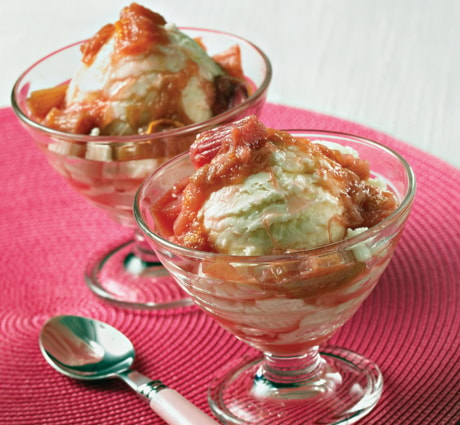In a revival of sorts, fresh rhubarb is getting the attention of the eat local folks, says fourth generation grower Bill French.
“It’s getting a little more popular and we’ve had quite a bit of interest in the past two years and increasing sales on the fresh market,” says French, whose farm north of Shelburne, Ont., produces the bulk of the crop for the province.
Rhubarb, a native of Northern Asia, was once only used for medicinal purposes. Popular in England, the wave of British immigrants in the 1800s and 1900s brought rhubarb cuttings to grow in their Canadian gardens.
In our part of the world, it’s the first harvest you can pull from your own garden, and growing it is pretty well effortless as far as care is concerned.
As a consequence (and perhaps because it’s not inherently sweet), rhubarb is considered a second-class garden resident, languishing somewhere in a forgotten corner.
Yet even so, it is so productive that it gets taken for granted, and not celebrated as the first fruits of summer.
Rhubarb is a member of the buckwheat family and is a vegetable, but because it is used in pies, cobblers, cakes and muffins, most people think it is a fruit, and a tart one at that.
The thick celery-like stalks can be up to 60 cm long. They are the only part of the plant that can be eaten because the fan-sized leaves are poisonous — they contain toxic oxalic acid.
In fact, leave a rhubarb leaf on the ground, and nothing will grow under it.
At one time, rhubarb was grown for processing and sold to pie companies, says Elaine Roddy, crops specialist for the Ontario Ministry of Agriculture and Rural Affairs.
“But just with competitive forces, like so many of our other processed crops, it has moved offshore,” she says. “It’s an expensive crop to produce and it’s hard to compete with developing countries.”
And she adds: “It’s too bad because one of the big varieties is Canadian Red and we don’t grow as much as we used to.”
One the largest growers of rhubarb for processing in Canada, French says his operation handled “over one million pounds a year.”
“The business has gone to Poland where they have a large land base to grow the crops and workers’ wages run around $1.50 per hour U.S.”
Roddy says that there aren’t many growers cultivating just rhubarb.
“It tends to be a very small part of many other fruits and vegetables that growers do. It might be something like six to eight rows of something he does for a few weeks in the spring.”
Roddy adds that fresh rhubarb tends to get sold at the farm gate or farmers’ markets.
“But it’s going to be hit and miss because a lot of the farmers markets don’t start until the strawberries arrive,” she says. “So you might see a bit of it along with the strawberries but it’s not a driving force and rhubarb is an impulse buy.”
Nutritionally, rhubarb contains vitamin C, potassium and fibre. Calorie-wise, a 250 ml (1 cup) serving has just 26 calories.
The drawback is that because of its tart flavour a substantial amount of sugar or other sweeteners have to be added to a recipe.
Our homegrown rhubarb season is early, but brief, so take advantage of this year’s crop while it’s in the marketplace or on roadside stands.
This quick and easy microwave recipe is great with frozen or regular yogurt and even delicious on French toast. Use fruit juice in place of rum if desired.
Granola gives a crunchy topping and boost of soluble fibre to these lightly spiced muffins. The rhubarb keeps them moist for several days and they freeze well. It’s agreat snack for the kids’ lunch boxes.
Rum and Rhubarb Compote
1 l (4 cups) chopped 2.5 cm (1-inch) pieces trimmed rhubarb (about 750 g/1.5 lb)
150 ml (2/3 cup) granulated sugar
45 ml (3 tbsp) rum
5 ml (1 tsp) grated orange rind
In 2 l (8 cup) microwaveable dish, combine rhubarb, sugar, 30 ml (2 tbsp) of the rum and orange rind. Cover with vented wrap and microwave on High for 5 to 6 minutes, gently stirring once, or until tender. Stir in remaining rum. Let cool (mixture will thicken). Serve warm or at room temperature.
Makes 625 ml (2 cups).
Nutritional information: 30 ml (2 tbsp) serving: 26 calories, 6 g carbohydrates.
Rhubarb Granola Muffins
425 ml (1 3/4 cups) all-purpose flour
425 ml (1 3/4 cups) honey almond granola (without raisins)
175 ml (3/4 cup) granulated sugar
10 ml (2 tsp) baking powder
10 ml (2 tsp) cinnamon
2 ml (1/2 tsp) salt
1 ml (1/4 tsp) nutmeg
2 eggs
175 ml (3/4 cup) 2 per cent milk
75 ml (1/3 cup) sunflower or canola oil
5 ml (1 tsp) vanilla
500 ml (2 cups) chopped (1 cm/ inch) pieces rhubarb
In medium bowl, mix together flour, 300 ml (1 1/4 cups) of the granola, sugar, baking powder, cinnamon, salt and nutmeg, breaking up any lumps in granola. In large bowl beat eggs; whisk in milk, oil and vanilla; stir in dry ingredients until almost combined. Stir in rhubarb.
Spoon into well-greased large muffin tins. Sprinkle remaining 125 ml (1/2 cup) granola over batter; press lightly on top.
Bake in 190 C (375 F) oven for 15 to 18 minutes or until tester comes out clean.
Makes 12 muffins.
Nutritional information per muffin:313 calories, 7 g protein, 11 g fat,46 g carbohydrates.
